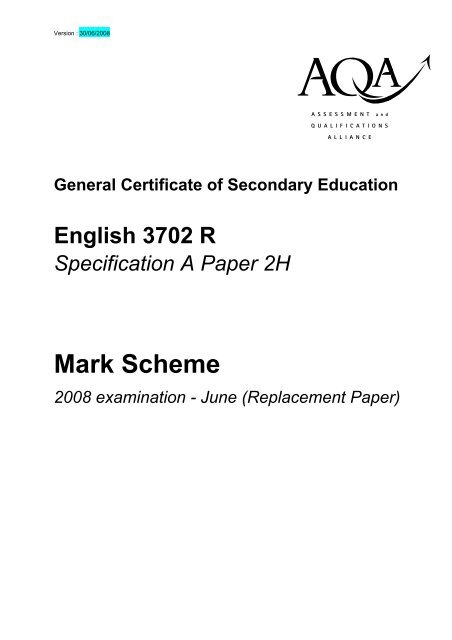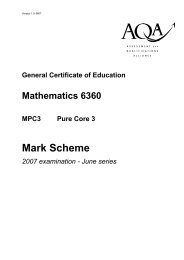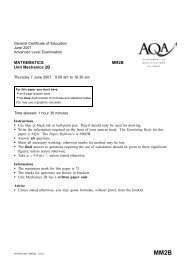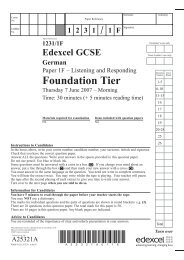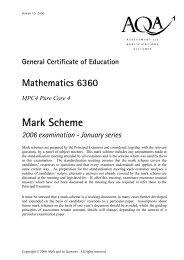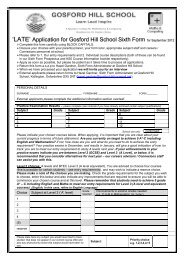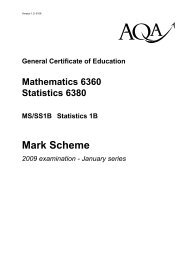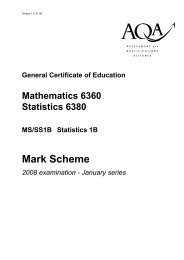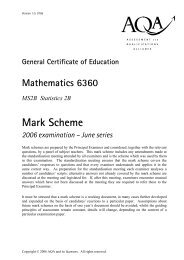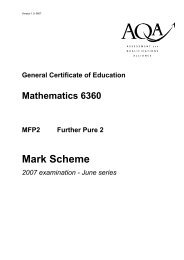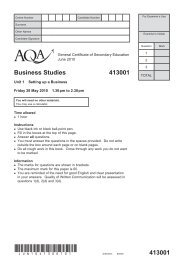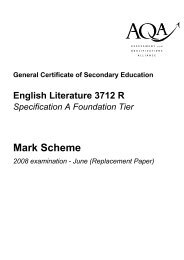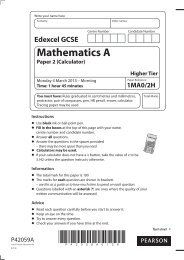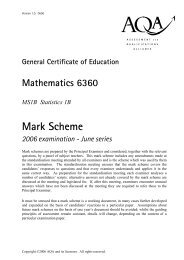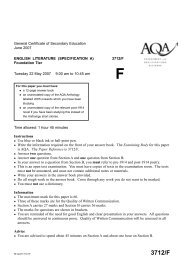GCSE English Language A Paper 2 Higher Mark Scheme June 2008
GCSE English Language A Paper 2 Higher Mark Scheme June 2008
GCSE English Language A Paper 2 Higher Mark Scheme June 2008
Create successful ePaper yourself
Turn your PDF publications into a flip-book with our unique Google optimized e-Paper software.
Version : 30/06/<strong>2008</strong><br />
abc<br />
General Certificate of Secondary Education<br />
<strong>English</strong> 3702 R<br />
Specification A <strong>Paper</strong> 2H<br />
<strong>Mark</strong> <strong>Scheme</strong><br />
<strong>2008</strong> examination - <strong>June</strong> (Replacement <strong>Paper</strong>)
<strong>Mark</strong> schemes are prepared by the Principal Examiner and considered, together with the<br />
relevant questions, by a panel of subject teachers. This mark scheme includes any<br />
amendments made at the standardisation meeting attended by all examiners and is the scheme<br />
which was used by them in this examination. The standardisation meeting ensures that the<br />
mark scheme covers the candidates’ responses to questions and that every examiner<br />
understands and applies it in the same correct way. As preparation for the standardisation<br />
meeting each examiner analyses a number of candidates’ scripts: alternative answers not<br />
already covered by the mark scheme are discussed at the meeting and legislated for. If, after<br />
this meeting, examiners encounter unusual answers which have not been discussed at the<br />
meeting they are required to refer these to the Principal Examiner.<br />
It must be stressed that a mark scheme is a working document, in many cases further<br />
developed and expanded on the basis of candidates’ reactions to a particular paper.<br />
Assumptions about future mark schemes on the basis of one year’s document should be<br />
avoided; whilst the guiding principles of assessment remain constant, details will change,<br />
depending on the content of a particular examination paper.<br />
Further copies of this <strong>Mark</strong> <strong>Scheme</strong> are available to download from the AQA Website: www.aqa.org.uk<br />
Copyright © <strong>2008</strong> AQA and its licensors. All rights reserved.<br />
COPYRIGHT<br />
AQA retains the copyright on all its publications. However, registered centres for AQA are permitted to copy material<br />
from this booklet for their own internal use, with the following important exception: AQA cannot give permission to<br />
centres to photocopy any material that is acknowledged to a third party even for internal use within the centre.<br />
Set and published by the Assessment and Qualifications Alliance.<br />
The Assessment and Qualifications Alliance (AQA) is a company limited by guarantee registered in England and Wales (company number 3644723) and a registered charity (registered charity number 1073334).<br />
Registered address: AQA, Devas Street, Manchester M15 6EX<br />
Dr Michael Cresswell Director General
<strong>English</strong> - AQA <strong>GCSE</strong> <strong>Mark</strong> <strong>Scheme</strong> <strong>2008</strong> <strong>June</strong> series R<br />
<strong>GCSE</strong> <strong>English</strong> <strong>2008</strong> Replacement<br />
<strong>Paper</strong> 2 Tier H <strong>Mark</strong> <strong>Scheme</strong><br />
INTRODUCTION<br />
Examiners will be expected to read the scripts in their allocation carefully and to make every<br />
effort to look positively for achievement throughout the ability range. They will be expected to<br />
annotate the scripts in order to show subsequent readers what evidence they have found for the<br />
achievement of the particular descriptors in the mark bands and will be expected to give a mark<br />
for each answer in the right-hand margin at the end of the answer.<br />
There is a common marking spine which runs across all components. In this way the whole<br />
examination can be integrated by using a common grade related system for all components.<br />
There are some rules, however, about the mark ranges that can be given.<br />
TIER H<br />
On Tier H, the questions are targeted at Grades A* to D. However, it is quite possible that on an<br />
individual essay or component candidates may perform below grade D and so there are also<br />
descriptors for grades below D.<br />
DECIDING ON A MARK<br />
Examiners must use the full range of marks. Work exhibiting the highest skills should be<br />
considered for full marks.<br />
<strong>Mark</strong>ing throughout must be on a ‘best-fit’ principle. Where there are both strengths and<br />
weaknesses in a particular answer, examiners should consider carefully which band is the best<br />
fit for the performance overall.<br />
The descriptors are an attempt to guide examiners to an understanding of the qualities normally<br />
expected of, or ‘typical’ of, work in the band. They must not be interpreted as hurdle<br />
statements.<br />
Once the mark has been decided upon, by the identification in the body of the script where the<br />
descriptor has been met, then the mark should be placed, circled, in the right-hand margin.<br />
3
<strong>English</strong> - AQA <strong>GCSE</strong> <strong>Mark</strong> <strong>Scheme</strong> <strong>2008</strong> <strong>June</strong> series R<br />
ANNOTATION OF SCRIPTS<br />
It is important that while they are marking in red, examiners note on the script where they have<br />
found specific evidence of candidates having achieved a descriptor. It is likely that examiners<br />
will be making more extensive annotations at the beginning of the marking period than at the<br />
end, but every mark must be justified by a written comment. Ticks should be used to identify<br />
evidence of particular skills. Random ticking is extremely unhelpful.<br />
The best kinds of comments are where a particular element of the descriptors is identified<br />
clearly and concisely. The point of making such comments is to allow subsequent readers to<br />
understand what you are identifying as positive achievement and where you are seeing material<br />
which gains credit. It is to share your marking process with those reading your scripts later<br />
(Team Leaders, Assistant Principals, Principals, the Chief, Awarders, QCA, scrutineers etc.).<br />
Examiners are asked to number the scripts in their allocation in the order in which they mark<br />
them. The first script marked is ‘1’. Go right through the allocation. Number the script in the<br />
top left-hand corner of the front cover of the script. If you do extra scripts (or ‘balcony’ marking,<br />
etc.) just keep numbering through.<br />
PROBLEMS<br />
Where an examiner has great difficulty in assessing a script, (s)he can draw it to the attention of<br />
the Principal Examiner at the end of the marking season by placing RSE (Refer to Senior<br />
Examiner) on the script and attaching the relevant Form EX/SRF. This means that it will be<br />
sent to the final meeting of examiners, the occasion where all the problems are looked at and a<br />
decision arrived at. Very occasionally a script is very hard to read or illegible. If you have one<br />
of these, you should give the mark you think it deserves, but you must also mark it RSE and<br />
complete Form EX/SRF so that it can be deciphered fully later on.<br />
RUBRIC INFRINGEMENTS<br />
There may well be a few candidates who answer the wrong number of questions. If so, mark<br />
them all and count the highest score for the three eligible under the terms of the rubric. Thus<br />
the marks should be entered which are the highest according to the allowable rubric.<br />
RECORDING<br />
In addition to recording the mark(s) for a question at the end of the answer and circling them,<br />
examiners must also fill in the marks on the front cover of the answer booklet. A mark must be<br />
entered for Section A and 2 marks for Section B. There will, therefore, be three marks to be<br />
placed alongside the question numbers, one above the other. These should then be totalled.<br />
The total mark and your initials should be placed in the boxes in the top right-hand corner of the<br />
answer booklet.<br />
The grid on the front of the answer booklet should look like this:<br />
2 21<br />
4 14<br />
7<br />
Then put the total for the paper in the box on the top right-hand corner of the cover marked ‘For<br />
Office Use Only’ and circle it. Put your initials underneath this total.<br />
4
<strong>English</strong> - AQA <strong>GCSE</strong> <strong>Mark</strong> <strong>Scheme</strong> <strong>2008</strong> <strong>June</strong> series R<br />
<strong>GCSE</strong> <strong>English</strong> <strong>2008</strong><br />
<strong>Paper</strong> 2 Tier H<br />
Section A: Reading<br />
This Section covers the following Assessment Objectives:<br />
AO2 reading (EN2)<br />
Candidates are required to demonstrate their ability to:<br />
(i)<br />
(iv)<br />
(v)<br />
read with insight and engagement making appropriate reference to texts and developing<br />
and sustaining interpretations of them;<br />
select material appropriate to purpose, collate material from different sources, and make<br />
cross references;<br />
understand and evaluate how writers use linguistic, structural and presentational devices<br />
to achieve their effects, and comment on ways language varies and changes.<br />
The <strong>Higher</strong> Tier targets Grades D to A*, but candidates may gain any mark on a particular<br />
component or question.<br />
Descriptors and content guides have been included for performance from U to A*.<br />
The range of marks targeted by the paper (notional D to A*) is 13 – 27 for each question in<br />
Section A. Each of the questions in Section A is marked out of 27.<br />
Specification A <strong>Paper</strong> 2 H Assessment Grid<br />
Assessment<br />
Question 1 Question 2<br />
Objectives<br />
AO2(i) ! !<br />
AO2(iv) ! !<br />
AO2(v) ! !<br />
5
<strong>English</strong> - AQA <strong>GCSE</strong> <strong>Mark</strong> <strong>Scheme</strong> <strong>2008</strong> <strong>June</strong> series R<br />
SECTION A: READING<br />
1 Compare how language and layout are used for effect in ‘Two Scavengers in a Truck,<br />
Two Beautiful People in a Mercedes’ (page 8) with the ways language and layout are<br />
used for effect in one other poem.<br />
(27 marks)<br />
Skills Descriptors<br />
<strong>Mark</strong><br />
Statements<br />
Band<br />
0 marks • nothing written<br />
1-3 • some awareness of one or<br />
marks more texts<br />
4-6 • simple comment<br />
marks • reference to some detail<br />
• awareness of some aspect of<br />
presentation<br />
7-9<br />
marks<br />
10-12<br />
marks<br />
13-15<br />
marks<br />
16-18<br />
marks<br />
• some simple comment<br />
supported<br />
• reference to appropriate<br />
detail/ simple linkage<br />
• statement on some aspects<br />
of presentation<br />
• extended unsupported<br />
comment<br />
• appropriate reference/use of<br />
quotation to support<br />
comment/linkage<br />
• simple comment on some<br />
aspects of presentation<br />
• awareness of feeling(s),<br />
attitude(s), idea(s)<br />
• range of comment supported<br />
by textual details with some<br />
valid cross-reference<br />
• comment on effects achieved<br />
by writer<br />
• understanding of feelings,<br />
attitudes, ideas<br />
• range of extended supported<br />
comment with some<br />
developed cross-reference<br />
• awareness of writer’s<br />
techniques and purpose<br />
<strong>Mark</strong><br />
Band<br />
1-6<br />
marks<br />
7-12<br />
marks<br />
13-18<br />
marks<br />
Content Descriptors<br />
Statements<br />
• some understanding of<br />
content of ‘Scavengers’ and/or<br />
one other poem<br />
• simple statements on layout<br />
e.g. the bin men are described<br />
as not very nice<br />
• simple statement on layout<br />
• accurate account of content of<br />
‘Scavengers’ and/or one other<br />
relevant poem<br />
• identification of aspects of<br />
language/layout e.g. the<br />
scavengers are described as<br />
grungy and like a gargoyle<br />
Quasimodo<br />
• simple comment on effects<br />
e.g. This makes them seem<br />
unpleasant and scruffy<br />
• some focus on the ideas in<br />
‘Scavengers’ and one other<br />
poem<br />
• comments on the effects<br />
created through the use of<br />
language and/or layout e.g.<br />
The repeated use of “elegant”<br />
to describe the couple makes<br />
them seem completely<br />
different to the scavengers<br />
• relevant comparison of uses<br />
of language and/or layout<br />
6
<strong>English</strong> - AQA <strong>GCSE</strong> <strong>Mark</strong> <strong>Scheme</strong> <strong>2008</strong> <strong>June</strong> series R<br />
<strong>Mark</strong><br />
Band<br />
19-21<br />
marks<br />
22-24<br />
marks<br />
25-27<br />
marks<br />
Skills Descriptors<br />
Statements<br />
• appreciation of feelings,<br />
attitudes and ideas<br />
• effective use of textual detail<br />
with integrated cross<br />
reference<br />
• understanding of a variety of<br />
writers’ techniques<br />
• exploration of and empathy<br />
with writers’ feelings,<br />
attitudes, ideas<br />
• references integrated with<br />
argument and comparison<br />
• analysis of a variety of<br />
writers’ techniques<br />
• consistent insight and<br />
convincing/imaginative<br />
interpretation<br />
• conceptualised comparative<br />
response<br />
• close textual analysis<br />
<strong>Mark</strong><br />
Band<br />
19-27<br />
marks<br />
Content Descriptors<br />
Statements<br />
• examination and analysis of<br />
the uses of language and<br />
layout in both poems<br />
• examination and analysis of<br />
specific effects, demonstrating<br />
sound understanding of<br />
authorial purpose e.g.<br />
examination of the ambiguity<br />
in the portrayal of the “cool<br />
couple”<br />
• integrated comparative<br />
approach, analysing and<br />
developing own response<br />
7
<strong>English</strong> - AQA <strong>GCSE</strong> <strong>Mark</strong> <strong>Scheme</strong> <strong>2008</strong> <strong>June</strong> series R<br />
2 Compare the ways poets use description in ‘from Search For My Tongue’ (page 12) and<br />
one other poem.<br />
(27 marks)<br />
Skills Descriptors<br />
<strong>Mark</strong><br />
Statements<br />
Band<br />
0 marks • nothing written<br />
1-3 marks • some awareness of one or<br />
more texts<br />
4-6 marks • simple comment<br />
• reference to some detail<br />
• awareness of some aspect of<br />
presentation<br />
7-9 marks • some simple comment<br />
supported<br />
• reference to appropriate<br />
detail/simple linkage<br />
• statement on some aspects<br />
10-12<br />
marks<br />
13-15<br />
marks<br />
16-18<br />
marks<br />
of presentation<br />
• extended unsupported<br />
comment<br />
• appropriate reference/use of<br />
quotation to support<br />
comment/linkage<br />
• simple comment on some<br />
aspects of presentation<br />
• awareness of feeling(s),<br />
attitude(s), idea(s)<br />
• range of comment supported<br />
by textual detail with some<br />
valid cross reference<br />
• comment on effects achieved<br />
by writer<br />
• understanding of feelings,<br />
attitudes, ideas<br />
• range of extended supported<br />
comment with some<br />
developed cross-reference<br />
• awareness of writer’s<br />
techniques and purpose<br />
<strong>Mark</strong><br />
Band<br />
1-6<br />
marks<br />
7-12<br />
marks<br />
13-18<br />
marks<br />
Content Descriptors<br />
Statements<br />
• some understanding of content of<br />
one or more poems<br />
• mention of descriptions<br />
• simple statement on what is<br />
described<br />
• accurate account of content of one<br />
or more relevant poems<br />
• identification of the kind(s) e.g. the<br />
tongue is described as a plant<br />
• simple comment on some effect(s)<br />
e.g. this makes it seem alive<br />
• some focus on ideas in ‘Search For<br />
My Tongue’ and one other poem<br />
• comments on the uses poets make<br />
of description e.g. Bhatt uses the<br />
image of a bud opening to show<br />
how her mother tongue is returning<br />
• relevant comparison of the mood,<br />
change, contrast, feelings, ideas<br />
etc.<br />
8
<strong>English</strong> - AQA <strong>GCSE</strong> <strong>Mark</strong> <strong>Scheme</strong> <strong>2008</strong> <strong>June</strong> series R<br />
<strong>Mark</strong><br />
Band<br />
19-21<br />
marks<br />
22-24<br />
marks<br />
25-27<br />
marks<br />
Skills Descriptors<br />
Statements<br />
• appreciation of feelings, attitudes<br />
and ideas<br />
• effective use of textual detail with<br />
integrated cross reference<br />
• understanding of a variety of<br />
writers’ techniques<br />
• exploration of and empathy with<br />
writers’ feelings, attitudes and<br />
ideas<br />
• references integrated with<br />
argument and comparison<br />
• analysis of a variety of writers’<br />
techniques<br />
• consistent insight and<br />
convincing/imaginative<br />
interpretation<br />
• conceptualised comparative<br />
response<br />
• close textual analysis<br />
<strong>Mark</strong><br />
Band<br />
19-27<br />
marks<br />
Content Descriptors<br />
Statements<br />
• examination and analysis of the<br />
possible meanings of the two<br />
poems<br />
• examination and analysis of<br />
specific uses of description<br />
• integrated comparative<br />
approach focusing on, for<br />
example, mood, senses,<br />
feelings; use of metaphor etc.<br />
9
<strong>English</strong> - AQA <strong>GCSE</strong> <strong>Mark</strong> <strong>Scheme</strong> <strong>2008</strong> <strong>June</strong> series R<br />
SECTION B: WRITING TO INFORM, EXPLAIN OR DESCRIBE<br />
Assessment Objectives<br />
AO3 (i) communicate clearly and imaginatively, using and adapting forms for different readers<br />
and purposes<br />
AO3 (ii) organise ideas into sentences, paragraphs and whole texts using a variety of linguistic<br />
and structural features<br />
AO3 (iii) use a range of sentence structures effectively with accurate punctuation and spelling.<br />
Descriptors have been included for performance from U to A*. The skills descriptors represent<br />
the base line generic expectations whilst the content descriptors offer guidance on how those<br />
expectations are likely to be demonstrated in a response.<br />
For each question, examiners are to record one mark out of 18 for AO3 (i) and (ii) combined<br />
and a separate mark out of 9 for AO3 (iii). The total available mark for Section B questions is<br />
therefore 27.<br />
For AO3 (i)/(ii), assess answers in terms of the levels below, i.e. the Communication and<br />
Organisation descriptors. For AO3 (iii), use the separate set of levels which follow. Ring the<br />
marks in the margin at the end of the answer, with the AO3 (i)/(ii) total above the AO3 (iii) total.<br />
The Skills descriptors embody the two equally weighted Assessment Objectives in the<br />
Communication and Organisation <strong>Mark</strong> <strong>Scheme</strong>s. These are amplified and customised for the<br />
question in the Content Descriptors. Examiners will need to look closely at the Content<br />
Descriptors in order to find the appropriate band, and then to check across to the Skills<br />
Descriptors to confirm or modify the preliminary judgement. Taking both Skills and Content<br />
Descriptors together will determine how high or low in the band the mark should be. Remember<br />
that to be placed in a particular band the work will satisfy some (but not necessarily all) of the<br />
criteria at that level. The precise mark awarded will be determined by the extent to which the<br />
answer matches the descriptors set out in the appropriate level.<br />
The one Assessment Objective tested in the sentence structures, punctuation and spelling <strong>Mark</strong><br />
<strong>Scheme</strong> has been split into its three constituent parts. These are amplified and customised in<br />
the Content Descriptors. The same process should be followed as in the previous <strong>Mark</strong><br />
<strong>Scheme</strong> to determine the mark to be awarded.<br />
In each case, a best fit principle may need to be applied where performance in response to the<br />
Assessment Objectives or parts of Assessment Objectives is uneven.<br />
Any valid responses should be rewarded. Remember that candidates are writing under timed<br />
conditions.<br />
10
<strong>English</strong> - AQA <strong>GCSE</strong> <strong>Mark</strong> <strong>Scheme</strong> <strong>2008</strong> <strong>June</strong> series R<br />
3 Write a letter to a Minister for Education informing him or her of the things you think<br />
should be done to improve education for teenagers.<br />
(27 marks)<br />
AO3 (i)/(ii) Communication and Organisation<br />
<strong>Mark</strong> Skills Descriptors Content Descriptors<br />
1-2 • communicates some meaning • some words in appropriate order<br />
• some simple sequencing of ideas • one or more points made<br />
3-4 • communicates some meaning with<br />
occasional sense of purpose and<br />
• makes one or more direct reference to<br />
changes<br />
audience<br />
• an indication of awareness of need to<br />
inform<br />
• may express personal feelings about what<br />
should be done but with little relevant detail<br />
• ideas are sequenced simply, but • order of ideas can be followed by reader<br />
generally appropriately<br />
5-6 • clear communication of ideas with<br />
more sense of purpose and<br />
audience<br />
• uses some organisational devices<br />
appropriately with occasional<br />
conscious selection of words<br />
7-8 • sustained awareness of purpose<br />
and audience<br />
• more conscious attempt to organise<br />
sentences into paragraphs with<br />
some attempt to use vocabulary for<br />
effect<br />
9-10 • conscious attempt to suit the needs<br />
of purpose and audience and begins<br />
to engage reader’s response<br />
• clear, if mechanical, paragraphing<br />
with more conscious use of<br />
vocabulary for effect<br />
• makes some linked points about what<br />
should be done<br />
• some awareness of need to inform,<br />
demonstrated by selection of points, though<br />
likely to be under-developed<br />
• may show awareness of audience by use of<br />
second person<br />
• may demonstrate occasional attempt to<br />
paragraph though likely to be random<br />
• some attempt to link ideas using<br />
connectives<br />
• more evidence of vocabulary selected to<br />
outline changes<br />
• clearer focus on what should be done with<br />
more developed points<br />
• may be mainly anecdotal and/or narrative in<br />
approach though clearly intended to inform<br />
• may use simple rhetorical devices to<br />
interest reader<br />
• paragraphing may be tabloid and/or, at<br />
times, correctly placed<br />
• beginnings of variety in vocabulary<br />
• clear focus on what should be done with<br />
some range of information<br />
• likely to outline in detail various aspects of<br />
what should be done<br />
• likely to maintain awareness of audience<br />
throughout<br />
• information is logically sequenced with<br />
paragraphs usually marking shift in focus<br />
• begins to convey feelings about what<br />
should be done through vocabulary choices<br />
11
<strong>English</strong> - AQA <strong>GCSE</strong> <strong>Mark</strong> <strong>Scheme</strong> <strong>2008</strong> <strong>June</strong> series R<br />
<strong>Mark</strong> Skills Descriptors Content Descriptors<br />
11-12 • clear identification with purpose and<br />
audience; begins to sustain reader’s<br />
• more evidence of selection of points to<br />
inform<br />
response<br />
• information likely to cover a range of<br />
aspects<br />
• may address reader directly<br />
• paragraphs are competently linked by<br />
• evidence of structure with usually<br />
coherent paragraphs and clear<br />
selection of vocabulary for effect<br />
13-14 • form, content and style are generally<br />
matched to purpose and audience<br />
• well structured, starting to use<br />
paragraphs to enhance meaning and<br />
with increasing sophistication in<br />
vocabulary choice and phrasing<br />
15-16 • form, content and style are consistently<br />
matched to purpose and audience<br />
• coherently structured with fluently<br />
linked sentence structures and<br />
paragraphs and evidence of conscious<br />
crafting<br />
17-18 • form, content and style are assuredly<br />
matched to purpose and audience;<br />
distinctive and consistently effective<br />
• controlled and sustained crafting with<br />
highly effective and delightful<br />
vocabulary choices<br />
content and language<br />
• control of question/answer approach,<br />
anecdote in context, emphasis etc. will<br />
be competent where used<br />
• discursive markers are becoming more<br />
integrated and are used to enhance the<br />
organisation of the information<br />
• detailed and well developed with clear<br />
outline of what should be done and<br />
examples to support points<br />
• begins to anticipate and respond to<br />
potential audience response<br />
• may selectively use a range of<br />
devices/approaches to provide variety<br />
and sustain reader’s interest<br />
• range of paragraph structures coherently<br />
linked<br />
• discursive markers are now coherently<br />
integrated<br />
• varied vocabulary used effectively<br />
• cogent focus on what should be done<br />
with wide range of interesting information<br />
• growing subtlety of purpose and ability to<br />
manipulate reader’s response<br />
• structured and developed using a range<br />
of means to effectively inform audience<br />
about what should be done<br />
• fluent control of range of devices and<br />
discursive markers<br />
• extensive vocabulary range<br />
• strong personal style<br />
• may use satire, irony, humour etc. but<br />
always fittingly and in context<br />
• demonstrates the ability to integrate a<br />
range of complex details from range of<br />
aspects of what should be done<br />
• discursive markers and a range of<br />
stylistic techniques are integrated into<br />
whole seamlessly and informatively<br />
• may use some inventive structural<br />
and/or linguistic devices<br />
12
<strong>English</strong> - AQA <strong>GCSE</strong> <strong>Mark</strong> <strong>Scheme</strong> <strong>2008</strong> <strong>June</strong> series R<br />
AO3 (iii) Sentence Structures, Punctuation and Spelling<br />
<strong>Mark</strong> Skills Descriptors Content Descriptors<br />
1 • some sentences<br />
• some accuracy in spelling of simple • some monosyllabic words spelt correctly<br />
words<br />
• random punctuation<br />
2-3 • in sentences • may use mainly simple and compound<br />
sentences with occasional complex<br />
sentences; may use discourse markers<br />
in a mechanical way<br />
• generally accurate basic spelling • some monosyllabic words spelt correctly<br />
• evidence of conscious punctuation • occasional full stops<br />
4-5 • uses a range of sentence structures • some conscious variation of syntax<br />
though not always grammatically<br />
secure; may link complex sentences<br />
with appropriate discourse markers e.g.<br />
because, another reason for; some use<br />
of modifiers<br />
• some accurate spelling of more • commonly used words spelt correctly<br />
complex words<br />
• starts to use a range of punctuation • general accuracy in use of capital letters<br />
and full stops<br />
6-7 • uses sentence forms for effect • constructions linked securely to<br />
discourse markers; may use parallel<br />
constructions, syntactical lists,<br />
adjectives, adverbs, minor sentences,<br />
for effect<br />
• generally secure in spelling<br />
• generally secure in punctuation which<br />
clarifies meaning and purpose<br />
8-9 • uses full range of appropriate sentence<br />
structures<br />
• achieves a high level of technical<br />
accuracy in spelling (occasional lapses<br />
may occur)<br />
• achieves a high level of technical<br />
accuracy in punctuation (occasional<br />
lapses may occur)<br />
• generally secure spelling of irregular,<br />
latinate, complex words<br />
• generally accurate in sentence<br />
demarcation, use of commas, question<br />
marks etc<br />
• clear and controlled manipulation of<br />
sentence structures for effect; may use<br />
wide range of appropriate discourse<br />
markers linked to syntactical choice;<br />
may use repetition, contrast, parallel<br />
phrases and clauses, verbal patterning<br />
to control sentence variety within<br />
paragraphs<br />
• accurate spelling<br />
• range of punctuation used in a<br />
sophisticated manner; colons and semicolons<br />
used correctly when appropriate<br />
13
<strong>English</strong> - AQA <strong>GCSE</strong> <strong>Mark</strong> <strong>Scheme</strong> <strong>2008</strong> <strong>June</strong> series R<br />
4 Choose a famous person whom you admire. Explain why you admire this person.<br />
(27 marks)<br />
AO3 (i)/(ii) Communication and Organisation<br />
<strong>Mark</strong> Skills Descriptors<br />
Content Descriptors<br />
1-2 • communicates some meaning • some words in appropriate order<br />
• some simple sequencing of ideas<br />
3-4 • communicates some meaning with<br />
occasional sense of purpose and<br />
audience<br />
• ideas are sequenced simply, but<br />
generally appropriately<br />
5-6 • clear communication of ideas with<br />
more sense of purpose and<br />
audience<br />
• uses some organisational devices<br />
appropriately with occasional<br />
conscious selection of words<br />
7-8 • sustained awareness of purpose<br />
and audience<br />
• more conscious attempt to<br />
organise sentences into<br />
paragraphs with some attempt to<br />
use vocabulary for effect<br />
• one or more points made<br />
• makes one or more direct reference to famous<br />
person<br />
• an indication of awareness of need to explain<br />
admiration. Uses appropriate words to explain<br />
e.g. because<br />
• may express personal feelings but with little<br />
relevant detail<br />
• order of ideas can be followed by reader<br />
• makes some linked points about famous<br />
person<br />
• some awareness of need to explain<br />
demonstrated by selection of points, though<br />
likely to be underdeveloped<br />
• may show awareness of purpose by use of<br />
first person<br />
• may demonstrate occasional attempts to<br />
paragraph though likely to be random<br />
• some attempt to link ideas using connectives<br />
e.g. I admire him because …<br />
• more evidence of vocabulary selected to show<br />
attractions of subject; limited in range<br />
• clearer focus on famous person and<br />
admiration with more developed points<br />
• may be mainly anecdotal and/or narrative in<br />
approach though clearly intended to explain<br />
• may use simple rhetorical devices to interest<br />
reader<br />
• paragraphing may be tabloid and/or, at times,<br />
correctly placed<br />
• beginnings of variety in vocabulary<br />
9-10 • conscious attempt to suit the needs<br />
of purpose and audience and<br />
begins to engage reader’s<br />
response<br />
• clear, if mechanical, paragraphing<br />
with more conscious use of<br />
vocabulary for effect<br />
• clear focus on famous person and admiration<br />
• evidence of a variety of explanations<br />
• likely to describe in detail various reasons for<br />
admiration<br />
• information is logically sequenced with<br />
paragraphs usually marking shift in focus<br />
• begins to convey engagement with the topic<br />
through vocabulary choices<br />
14
<strong>English</strong> - AQA <strong>GCSE</strong> <strong>Mark</strong> <strong>Scheme</strong> <strong>2008</strong> <strong>June</strong> series R<br />
<strong>Mark</strong> Skills Descriptors Content Descriptors<br />
11-12 • clear identification with purpose<br />
and audience; begins to sustain<br />
• more evidence of selection of material for<br />
explanation and interest<br />
reader’s response<br />
• explanations likely to cover a range of<br />
aspects of admiration<br />
• paragraphs are competently linked by<br />
• evidence of structure with usually<br />
coherent paragraphs and clear<br />
selection of vocabulary for effect<br />
13-14 • form, content and style are<br />
generally matched to purpose and<br />
audience<br />
• well structured, starting to use<br />
paragraphs to enhance meaning<br />
and with increasing sophistication<br />
in vocabulary choice and phrasing<br />
15-16 • form, content and style are<br />
consistently matched to purpose<br />
and audience<br />
• coherently structured with fluently<br />
linked sentence structures and<br />
paragraphs and evidence of<br />
conscious crafting<br />
17-18 • form, content and style are<br />
assuredly matched to purpose and<br />
audience; distinctive and<br />
consistently effective<br />
• controlled and sustained crafting<br />
with highly effective and delightful<br />
vocabulary choices<br />
content and language<br />
• control of anecdote in context, emphasis etc.<br />
will be competent where used<br />
• discursive markers are becoming more<br />
integrated and are used to enhance the<br />
organisation<br />
• detailed and well developed with clear outline<br />
and examples to support explanations of<br />
admiration<br />
• begins to anticipate and respond to potential<br />
audience response<br />
• may selectively use a range of<br />
devices/approaches to provide variety and<br />
sustain reader’s interest e.g. rhetorical<br />
questions, anecdote, emotive language etc.<br />
• range of paragraph structures coherently<br />
linked<br />
• discursive markers are now coherently<br />
integrated<br />
• varied vocabulary used effectively<br />
• cogent focus on admiration with wide range<br />
of interesting explanations<br />
• growing subtlety of purpose and ability to<br />
manipulate reader’s response<br />
• structured and developed using a range of<br />
means to explain choice effectively<br />
• fluent control of range of devices and<br />
discursive markers<br />
• extensive vocabulary range<br />
• strong personal style<br />
• may use satire, irony, humour etc. but always<br />
fittingly and in context<br />
• demonstrates the ability to integrate a range<br />
of explanations<br />
• discursive markers and a range of stylistic<br />
techniques are integrated into whole<br />
seamlessly<br />
• may use some inventive structural and/or<br />
linguistic devices<br />
15
<strong>English</strong> - AQA <strong>GCSE</strong> <strong>Mark</strong> <strong>Scheme</strong> <strong>2008</strong> <strong>June</strong> series R<br />
AO3 (iii) Sentence Structures, Punctuation and Spelling<br />
<strong>Mark</strong> Skills Descriptors Content Descriptors<br />
1 • some sentences<br />
• some accuracy in spelling of • some monosyllabic words spelt correctly<br />
simple words<br />
• random punctuation<br />
2-3 • in sentences • may use mainly simple and compound<br />
sentences with occasional complex<br />
sentences; may use discourse markers in a<br />
mechanical way<br />
• generally accurate basic spelling • some monosyllabic words spelt correctly<br />
• evidence of conscious punctuation<br />
4-5 • uses a range of sentence<br />
structures<br />
• some accurate spelling of more<br />
complex words<br />
• starts to use a range of<br />
punctuation<br />
• occasional full stops<br />
• some conscious variation of syntax though<br />
not always grammatically secure; may link<br />
complex sentences with appropriate<br />
discourse markers e.g. because, another<br />
reason for; some use of modifiers<br />
• commonly used words spelt correctly<br />
• general accuracy in use of capital letters<br />
and full stops<br />
6-7 • uses sentence forms for effect • constructions linked securely to discourse<br />
markers; may use parallel constructions,<br />
syntactical lists, adjectives, adverbs, minor<br />
sentences, for effect<br />
• generally secure in spelling<br />
• generally secure in punctuation<br />
which clarifies meaning and<br />
purpose<br />
8-9 • uses full range of appropriate<br />
sentence structures<br />
• achieves a high level of technical<br />
accuracy in spelling (occasional<br />
lapses may occur)<br />
• achieves a high level of technical<br />
accuracy in punctuation<br />
(occasional lapses may occur)<br />
• generally secure spelling of irregular,<br />
latinate, complex words<br />
• generally accurate in sentence demarcation,<br />
use of commas, question marks etc<br />
• clear and controlled manipulation of<br />
sentence structures for effect; may use wide<br />
range of appropriate discourse markers<br />
linked to syntactical choice; may use<br />
repetition, contrast, parallel phrases and<br />
clauses, verbal patterning to control<br />
sentence variety within paragraphs<br />
• accurate spelling<br />
• range of punctuation used in a sophisticated<br />
manner; colons and semi-colons used<br />
correctly when appropriate<br />
16
<strong>English</strong> - AQA <strong>GCSE</strong> <strong>Mark</strong> <strong>Scheme</strong> <strong>2008</strong> <strong>June</strong> series R<br />
5 Describe a dream world. (27 marks)<br />
AO3(i)(ii) Communication and Organisation<br />
<strong>Mark</strong> Skills Descriptors Content Descriptors<br />
1-2 • communicates some meaning • some words in appropriate order<br />
• some simple sequencing of ideas • one or more features mentioned<br />
3-4 • communicates some meaning with<br />
occasional sense of purpose and<br />
• makes one or more direct reference to dream<br />
world<br />
audience<br />
• an indication of awareness of need to<br />
describe: uses appropriate adjectives<br />
• may express personal feelings about the<br />
dream world<br />
• ideas are sequenced simply, but • order of ideas can be followed by reader<br />
generally appropriately<br />
5-6 • clear communication of ideas with<br />
more sense of purpose and<br />
audience<br />
• uses some organisational devices<br />
appropriately with occasional<br />
conscious selection of words<br />
7-8 • sustained awareness of purpose<br />
and audience<br />
• more conscious attempt to<br />
organise sentences into<br />
paragraphs with some attempt to<br />
use vocabulary for effect<br />
9-10 • conscious attempt to suit the<br />
needs of purpose and audience<br />
and begins to engage reader’s<br />
response<br />
• clear, if mechanical, paragraphing<br />
with more conscious use of<br />
vocabulary for effect<br />
• makes some linked points about the dream<br />
world<br />
• some awareness of need to describe<br />
demonstrated by selection of aspects of the<br />
world though likely to be underdeveloped<br />
• may demonstrate occasional attempt to<br />
paragraph though likely to be random<br />
• some attempt to link ideas using connectives<br />
• more evidence of vocabulary selected to<br />
show the dream world; limited in range<br />
• clearer focus on the dream world with more<br />
developed description<br />
• may be anecdotal and/or narrative in<br />
approach though clearly intended to be<br />
descriptive<br />
• may use simple rhetorical devices to interest<br />
reader<br />
• paragraphing may be tabloid and/or, at<br />
times, correctly placed<br />
• beginnings of variety in vocabulary<br />
• clear focus on dream world<br />
• evidence of description of a range of features<br />
• likely to describe in detail various aspects of<br />
the dream world<br />
• description is logically sequenced with<br />
paragraphs usually marking shift in focus<br />
• begins to convey enthusiasm for subject<br />
through vocabulary choices<br />
17
<strong>English</strong> - AQA <strong>GCSE</strong> <strong>Mark</strong> <strong>Scheme</strong> <strong>2008</strong> <strong>June</strong> series R<br />
<strong>Mark</strong> Skills Descriptors Content Descriptors<br />
11-12 • clear identification with purpose<br />
and audience; begins to sustain<br />
reader’s response<br />
• more evidence of selection of detail for<br />
interest and sequencing of description of<br />
dream world<br />
• description likely to cover a range of aspects<br />
• evidence of structure with usually<br />
coherent paragraphs and clear<br />
selection of vocabulary for effect<br />
13-14 • form, content and style are<br />
generally matched to purpose and<br />
audience<br />
• well structured, starting to use<br />
paragraphs to enhance meaning<br />
and with increasing sophistication<br />
in vocabulary choice and phrasing<br />
15-16 • form, content and style are<br />
consistently matched to purpose<br />
and audience<br />
• coherently structured with fluently<br />
linked sentence structures and<br />
paragraphs and evidence of<br />
conscious crafting<br />
17-18 • form, content and style are<br />
assuredly matched to purpose and<br />
audience; distinctive and<br />
consistently effective<br />
• controlled and sustained crafting<br />
with highly effective and delightful<br />
vocabulary choices<br />
e.g. atmosphere<br />
• paragraphs are competently linked by<br />
content and language<br />
• control of parallel structure, shaping, links,<br />
modifiers will be competent where used<br />
• discursive markers are becoming more<br />
integrated and are used to enhance the<br />
organisation of the description<br />
• detailed and well developed with clear outline<br />
and examples to build description of dream<br />
world<br />
• begins to anticipate and respond to potential<br />
audience response<br />
• may selectively use a range of<br />
devices/approaches to provide variety and<br />
sustain reader’s interest e.g. sentence<br />
variation, parallelism<br />
• range of paragraph structures coherently<br />
linked<br />
• discursive markers are now coherently<br />
integrated<br />
• wide vocabulary used effectively<br />
• cogent focus on the dream world with a wide<br />
range of interesting description<br />
• growing subtlety of purpose and ability to<br />
manipulate reader’s response<br />
• structured and developed using a range of<br />
means to convey the dream world effectively<br />
• fluent control of range of devices and<br />
discursive markers<br />
• extensive vocabulary range<br />
• strong personal style<br />
• may use satire, irony, humour etc. but always<br />
fittingly and in context<br />
• demonstrates the ability to integrate a range<br />
of complex details<br />
• discursive markers and a range of stylistic<br />
techniques are integrated into whole<br />
seamlessly<br />
• may use some inventive structural and/or<br />
linguistic devices<br />
18
<strong>English</strong> - AQA <strong>GCSE</strong> <strong>Mark</strong> <strong>Scheme</strong> <strong>2008</strong> <strong>June</strong> series R<br />
AO3 (iii) Sentence Structures, Punctuation and Spelling<br />
<strong>Mark</strong> Skills Descriptors Content Descriptors<br />
1 • some sentences<br />
• some accuracy in spelling of • some monosyllabic words spelt correctly<br />
simple words<br />
• random punctuation<br />
2-3 • in sentences • may use mainly simple and compound<br />
sentences with occasional complex<br />
sentences; may use discourse markers in a<br />
mechanical way<br />
• generally accurate basic spelling • some monosyllabic words spelt correctly<br />
• evidence of conscious punctuation<br />
4-5 • uses a range of sentence<br />
structures<br />
• some accurate spelling of more<br />
complex words<br />
• starts to use a range of<br />
punctuation<br />
• occasional full stops<br />
• some conscious variation of syntax though<br />
not always grammatically secure; may link<br />
complex sentences with appropriate<br />
discourse markers e.g. because, another<br />
reason for; some use of modifiers<br />
• commonly used words spelt correctly<br />
• general accuracy in use of capital letters and<br />
full stops<br />
6-7 • uses sentence forms for effect • constructions linked securely to discourse<br />
markers; may use parallel constructions,<br />
syntactical lists, adjectives, adverbs, minor<br />
sentences, for effect<br />
• generally secure in spelling<br />
• generally secure in punctuation<br />
which clarifies meaning and<br />
purpose<br />
8-9 • uses full range of appropriate<br />
sentence structures<br />
• achieves a high level of technical<br />
accuracy in spelling (occasional<br />
lapses may occur)<br />
• achieves a high level of technical<br />
accuracy in punctuation<br />
(occasional lapses may occur)<br />
• generally secure spelling of irregular,<br />
latinate, complex words<br />
• generally accurate in sentence demarcation,<br />
use of commas, question marks etc<br />
• clear and controlled manipulation of<br />
sentence structures for effect; may use wide<br />
range of appropriate discourse markers<br />
linked to syntactical choice; may use<br />
repetition, contrast, parallel phrases and<br />
clauses, verbal patterning to control<br />
sentence variety within paragraphs<br />
• accurate spelling<br />
• range of punctuation used in a sophisticated<br />
manner; colons and semi-colons used<br />
correctly when appropriate<br />
19
<strong>English</strong> - AQA <strong>GCSE</strong> <strong>Mark</strong> <strong>Scheme</strong> <strong>2008</strong> <strong>June</strong> series R<br />
6 Choose an event from your past that has special significance for you. Describe what<br />
happened and explain how you feel about it.<br />
(27 marks)<br />
AO3(i)/(ii) Communication and Organisation<br />
<strong>Mark</strong> Skills Descriptors Content Descriptors<br />
1-2 • communicates some meaning • some words in appropriate order<br />
• some simple sequencing of ideas • one or more points made<br />
3-4 • communicates some meaning with • makes one or more direct reference to event<br />
occasional sense of purpose and<br />
audience<br />
• an indication of awareness of need to<br />
describe and explain<br />
• may express personal feelings about<br />
concern(s) but with little relevant detail<br />
• ideas are sequenced simply, but • order of ideas can be followed by reader<br />
generally appropriately<br />
5-6 • clear communication of ideas with<br />
more sense of purpose and<br />
audience<br />
• uses some organisational devices<br />
appropriately with occasional<br />
conscious selection of words<br />
7-8 • sustained awareness of purpose<br />
and audience<br />
• more conscious attempt to<br />
organise sentences into<br />
paragraphs with some attempt to<br />
use vocabulary for effect<br />
9-10 • conscious attempt to suit the<br />
needs of purpose and audience<br />
and begins to engage reader’s<br />
response<br />
• clear, if mechanical, paragraphing<br />
with more conscious use of<br />
vocabulary for effect<br />
• makes some linked points<br />
• some awareness of need to describe and<br />
explain demonstrated by selection of aspects<br />
of event and feelings, though likely to be<br />
underdeveloped<br />
• may show awareness of audience by use of<br />
first person explanation<br />
• may demonstrate occasional attempt to<br />
paragraph though likely to be random<br />
• some attempt to link ideas using connectives<br />
e.g. because …<br />
• more evidence of vocabulary selected to<br />
inform and explain<br />
• clearer focus on event with more developed<br />
explanation of feelings<br />
• may be mainly anecdotal and/or narrative in<br />
approach though clearly intended to describe<br />
and explain<br />
• may use simple rhetorical device to interest<br />
reader<br />
• paragraphing may be tabloid and/or, at<br />
times, correctly placed<br />
• beginnings of variety in vocabulary<br />
• clear focus on event with some range in<br />
description<br />
• likely to explain aspects of feelings<br />
• paragraphs usually marking shift in focus<br />
• detail is logically sequenced<br />
• begins to convey enthusiasm for subject<br />
through vocabulary choices<br />
20
<strong>English</strong> - AQA <strong>GCSE</strong> <strong>Mark</strong> <strong>Scheme</strong> <strong>2008</strong> <strong>June</strong> series R<br />
<strong>Mark</strong> Skills Descriptors Content Descriptors<br />
11-12 • clear identification with purpose<br />
and audience; begins to sustain<br />
• more evidence of selection of descriptive<br />
detail<br />
reader’s response<br />
• explanation likely to cover a range of aspects<br />
of feelings and the reasons for these<br />
• may address reader directly and effectively<br />
• paragraphs are competently linked by<br />
• evidence of structure with usually<br />
coherent paragraphs and clear<br />
selection of vocabulary for effect<br />
13-14 • form, content and style are<br />
generally matched to purpose and<br />
audience<br />
• well structured, starting to use<br />
paragraphs to enhance meaning<br />
and with increasing sophistication<br />
in vocabulary choice and phrasing<br />
15-16 • form, content and style are<br />
consistently matched to purpose<br />
and audience<br />
• coherently structured with fluently<br />
linked sentence structures and<br />
paragraphs and evidence of<br />
conscious crafting<br />
17-18 • form, content and style are<br />
assuredly matched to purpose and<br />
audience; distinctive and<br />
consistently effective<br />
• controlled and sustained crafting<br />
with highly effective and delightful<br />
vocabulary choices<br />
content and language<br />
• control of alternative structure, e.g. narrative,<br />
will be competent where used<br />
• discursive markers are becoming more<br />
integrated and are used to enhance the<br />
organisation of the information and<br />
explanation<br />
• detailed and well developed with clear<br />
description and explanation<br />
• begins to anticipate and respond to potential<br />
audience response<br />
• may selectively use a range of<br />
devices/approaches to provide variety and<br />
sustain reader’s interest<br />
• range of paragraph structures coherently<br />
linked<br />
• discursive markers are now coherently<br />
integrated<br />
• wide vocabulary used effectively<br />
• cogent focus on event and feelings with wide<br />
range of interesting detail<br />
• growing subtlety of purpose and ability to<br />
manipulate reader’s response<br />
• structured and developed using a range of<br />
means to provide description and<br />
explanation<br />
• fluent control of range of devices and<br />
discursive markers<br />
• extensive vocabulary range<br />
• strong personal style<br />
• may use satire, irony, humour etc. but always<br />
fittingly and in context<br />
• demonstrates the ability to integrate a range<br />
of complex details<br />
• discursive markers and a range of stylistic<br />
techniques are integrated into whole<br />
seamlessly and informatively<br />
• may use some inventive structural and/or<br />
linguistic devices<br />
21
<strong>English</strong> - AQA <strong>GCSE</strong> <strong>Mark</strong> <strong>Scheme</strong> <strong>2008</strong> <strong>June</strong> series R<br />
AO3 (iii) Sentence Structures, Punctuation and Spelling<br />
<strong>Mark</strong> Skills Descriptors Content Descriptors<br />
1 • some sentences<br />
• some accuracy in spelling of • some monosyllabic words spelt correctly<br />
simple words<br />
• random punctuation<br />
2-3 • in sentences • may use mainly simple and compound<br />
sentences with occasional complex<br />
sentences; may use discourse markers in a<br />
mechanical way<br />
• generally accurate basic spelling • some monosyllabic words spelt correctly<br />
• evidence of conscious punctuation<br />
4-5 • uses a range of sentence<br />
structures<br />
• some accurate spelling of more<br />
complex words<br />
• starts to use a range of<br />
punctuation<br />
• occasional full stops<br />
• some conscious variation of syntax though<br />
not always grammatically secure; may link<br />
complex sentences with appropriate<br />
discourse markers e.g. because, another<br />
reason for; some use of modifiers;<br />
• commonly used words spelt correctly<br />
• general accuracy in use of capital letters<br />
and full stops<br />
6-7 • uses sentence forms for effect • constructions linked securely to discourse<br />
markers; may use parallel constructions,<br />
syntactical lists, adjectives, adverbs, minor<br />
sentences, for effect<br />
• generally secure in spelling<br />
• generally secure in punctuation<br />
which clarifies meaning and<br />
purpose<br />
8-9 • uses full range of appropriate<br />
sentence structures<br />
• achieves a high level of technical<br />
accuracy in spelling (occasional<br />
lapses may occur)<br />
• achieves a high level of technical<br />
accuracy in punctuation<br />
(occasional lapses may occur)<br />
• generally secure spelling of irregular,<br />
latinate, complex words<br />
• generally accurate in sentence demarcation,<br />
use of commas, question marks etc<br />
• clear and controlled manipulation of<br />
sentence structures for effect; may use wide<br />
range of appropriate discourse markers<br />
linked to syntactical choice; may use<br />
repetition, contrast, parallel phrases and<br />
clauses, verbal patterning to control<br />
sentence variety within paragraphs<br />
• accurate spelling<br />
• range of punctuation used in a sophisticated<br />
manner; colons and semi-colons used<br />
correctly when appropriate<br />
22


